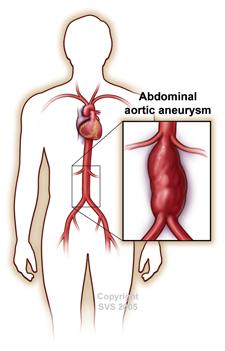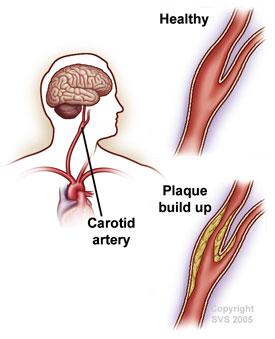What is Vascular Disease?
Vascular disease is any disease of your vascular system, which includes your veins and arteries.
Most Americans are familiar with heart disease and with the consequences of blockages in the vessels that carry blood to and from the heart. But few people realize that blockages caused by a buildup of plaque and cholesterol affect more than coronary arteries. Arteries throughout the body carry oxygen-rich blood away from the heart, so blockages can occur in all arteries with serious effects.
Three of the most recognized vascular diseases include:

Abdominal Aortic Aneurysm
Abdominal Aortic Aneurysm (AAA) is an enlargement or “bulge” that develops in a weakened area within the largest artery in the abdomen. The pressure generated by each heartbeat pushes against the weakened aortic wall, causing the aneurysm to enlarge. If the AAA remains undetected, the aortic wall continues to weaken, and the aneurysm continues to grow. Eventually, the aneurysm becomes so large, and its wall so weak, that rupture occurs. When this happens there is massive internal bleeding, a situation that is usually fatal. The only way to break this cycle is to find the AAA before it ruptures.
Carotid Artery Disease - Stroke

Carotid arteries occur when the main blood vessels to the brain develop a buildup of plaque caused by atherosclerosis, or hardening of the arteries. When the buildup becomes very severe, it can cause a stroke. A stroke occurs when part of the brain is damaged by these vascular problems; in fact, 80 percent of strokes are “ischemic strokes” where part of the circulation to the brain is cut off, usually due to blockages in the carotid arteries. The process is similar to the buildup of plaque in arteries in the heart that causes heart attacks. Strokes are the third leading cause of death in the United States according to the National Center for Health Statistics.
LEARN ABOUT CAD LEARN ABOUT STROKE
Peripheral Arterial Disease

Peripheral arterial disease (PAD) occurs when atherosclerosis, or hardening of the arteries, causes a buildup of plaque in the blood vessels that carry oxygen and nutrients to all the tissues of the body. As these plaques worsen, they reduce essential blood flow to the limbs and can even cause complete blockages of the arteries. Early on, PAD may only cause difficulty walking, but in its most severe forms, it can cause painful foot ulcers, infections, and even gangrene, which could require amputation. People with PAD are three times more likely to die of heart attacks or strokes than those without PAD.
The information contained on Vascular.org is not intended, and should not be relied upon, as a substitute for medical advice or treatment. It is very important that individuals with specific medical problems or questions consult with their doctor or other health care professional.